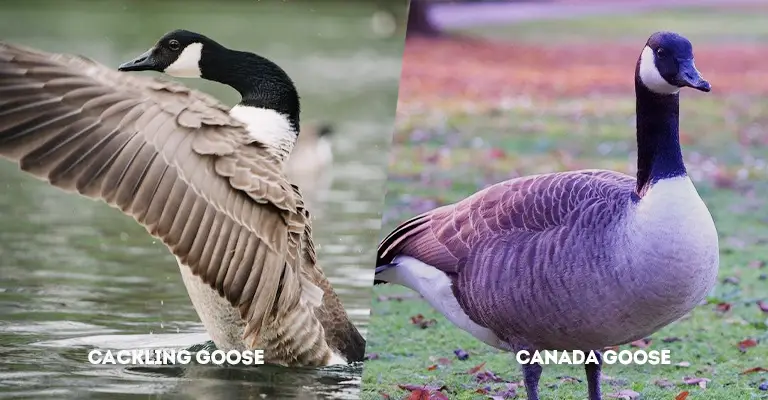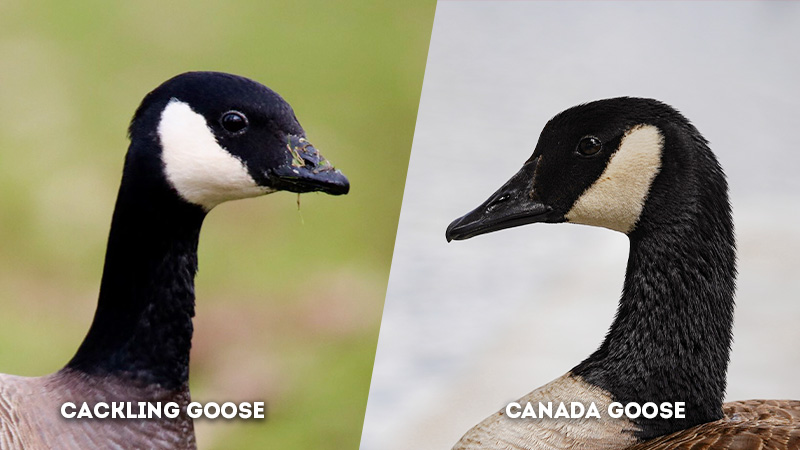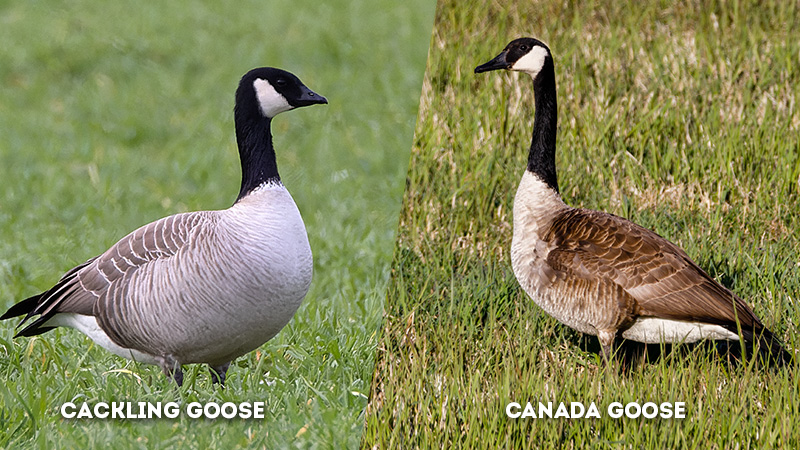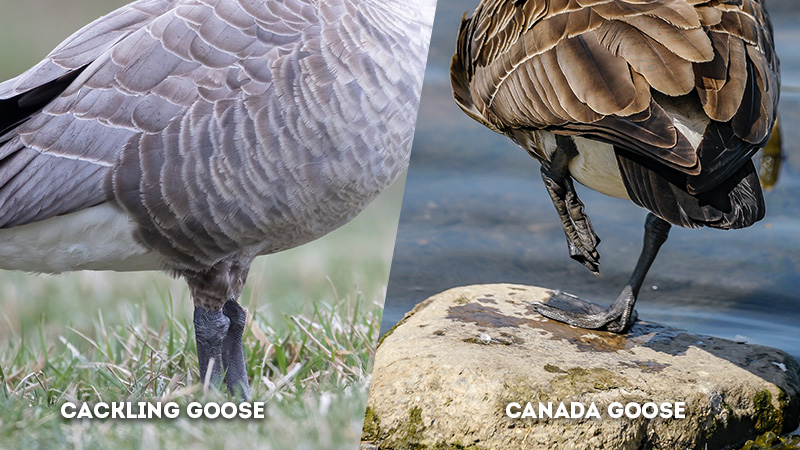The comparison between Cackling Geese and Canada Geese offers insights into the nuances that distinguish these avian species.
While both belong to the goose family, their differences extend beyond mere appearances, encompassing traits such as size, habitat preferences, behaviors, and even vocalizations.
Exploring these distinctions sheds light on the remarkable diversity within the natural world and underscores the importance of keen observation and understanding to accurately identify and appreciate these two closely related waterfowl.

Key Differences Between Cackling Goose and Canada Goose
Size Differences
- Cackling Goose: Cackling Geese are notably smaller compared to Canada Geese. They have a shorter bill and neck, which gives them a more compact appearance overall. This size difference can be quite distinct, especially when observed side by side with Canada Geese.
- Canada Goose: Canada Geese are larger in size, with a larger bill and a longer neck. This larger stature contributes to their overall robust appearance.
While they vary in size, some Canada Geese can even approach the dimensions of smaller Cackling Geese, making it important to consider additional characteristics for accurate identification.
Head Shape

- Cackling Goose: Cackling Geese are characterized by a steeper forehead, resulting in a more abrupt transition from their bill to the crown of their head. This feature lends a distinct look to their appearance, setting them apart from other geese.
- Canada Goose: Canada Geese exhibit a rounder head shape with a sloping forehead. This creates a smoother and more gradual curve from their bill to the top of their head. This head shape is a key identifier, especially when differentiating from Cackling Geese.
Vocalizations
- Cackling Goose: Cackling Geese possess unique vocalizations that contribute to their identification. While their calls can vary among subspecies, they often exhibit higher-pitched calls that can be distinguished with experience.
Recognizing these vocalizations can aid in identifying Cackling Geese in the field, especially in areas where they are present. - Canada Goose: Canada Geese also have distinct vocalizations, with various calls that can differ by subspecies. Their calls tend to be lower-pitched and more resonant compared to those of Cackling Geese.
These calls can range from honking to hissing, and they play a role in communication and coordination within flocks.
Coloration
- Cackling Goose: The coloration of Cackling Geese can vary based on their subspecies and individual characteristics. Generally, their color patterns include a mix of light and dark tones, with variations in neck and body markings.
These differences can make identification challenging, but understanding the coloration typical of Cackling Geese can aid in distinguishing them from other geese. - Canada Goose: Canada Geese exhibit a diverse range of color patterns influenced by their subspecies. Their bodies often display contrasting light and dark shades, with distinct markings on their necks and heads.
These patterns can be intricate and vary significantly among individuals. By familiarizing oneself with the common coloration of Canada Geese, observers can better differentiate them from other species.
Subspecies Variation
- Cackling Goose: The Cackling Goose species is composed of multiple subspecies, each with its own unique characteristics.
These subspecies can differ in terms of size, coloration, and habitat preferences. Identifying subspecies within the Cackling Goose group can add another layer of complexity to their identification. - Canada Goose: Similarly, Canada Geese also consist of various subspecies, each with distinct traits. These differences can include size, color patterns, and behaviors.
Understanding these variations among Canada Goose subspecies contributes to accurate identification, especially when differentiating them from Cackling Geese.
Size Variation
- Cackling Goose: One of the intriguing aspects of Cackling Geese is their size variation. Generally smaller in stature compared to Canada Geese, Cackling Geese are characterized by shorter bills and necks, contributing to a more compact appearance.
However, it’s important to note that some smaller subspecies of Canada Geese can closely resemble Cackling Geese in size, leading to potential confusion in identification. - Canada Goose: Canada Geese exhibit a broader range of sizes compared to Cackling Geese. While many Canada Geese are larger with longer necks and bills, some populations, particularly smaller subspecies, can approach the size of Cackling Geese.
This size overlap emphasizes the importance of examining other distinguishing characteristics to avoid misidentifications.
Range and Habitat
- Cackling Goose: Cackling Geese have a diverse range across North America, but their distribution may differ depending on the subspecies.
They can be found in various habitats, including grasslands, wetlands, and open fields. Some subspecies of Cackling Geese even prefer coastal areas. - Canada Goose: Canada Geese are renowned for their adaptability to various habitats. They are also widely distributed across North America, often congregating in areas with water bodies such as lakes, rivers, and ponds. Their presence can extend to urban and suburban environments as well.
Bill Length
- Cackling Goose: The bill length of Cackling Geese is notably shorter compared to that of Canada Geese. This feature, along with their smaller overall size, contributes to their compact appearance. A shorter bill is a consistent characteristic in Cackling Geese, making it a reliable feature for identification.
- Canada Goose: Canada Geese are easily distinguished by their larger bills. These bills are not only longer but also more substantial, contributing to their overall robust appearance. The difference in bill length between the two species is a significant clue when identifying them in the field.
Neck Length
- Cackling Goose: Cackling Geese possess shorter necks in proportion to their bodies. This contributes to their compact and rounded appearance, setting them apart from Canada Geese. While neck length is a defining feature, it’s important to remember that individual variation within both species can influence neck proportions.
- Canada Goose: Canada Geese are characterized by their longer necks, which can contribute to their distinctive posture and appearance. The extended neck is a prominent feature, especially when observed alongside Cackling Geese with their comparatively shorter necks.
Body Shape

- Cackling Goose: The body shape of Cackling Geese is generally more compact and smaller. Their shorter necks and bills, combined with a relatively smaller overall size, create a distinct silhouette. This compactness contributes to their unique appearance and aids in differentiation.
- Canada Goose: Canada Geese exhibit a larger and more robust body shape. Their longer necks and bills, along with their overall size, contribute to a more substantial appearance. The difference in body shape between the two species is noticeable and serves as a key identifier in the field.
Behavior
- Cackling Goose: Cackling Geese share several behavioral traits with Canada Geese. They exhibit social behaviors such as forming tight-knit family groups and flocks. Both species are known for their distinctive V-shaped flight formations during migration.
Cackling Geese can be observed foraging in fields and wetlands, where they feed on grasses and aquatic plants. - Canada Goose: Similarly, Canada Geese are known for their social nature, often congregating in large flocks year-round. They are highly adaptable and can be found in various environments, including urban areas.
Both species exhibit territorial behavior, particularly during the breeding season, and can become quite vocal to defend their territories.
Migration Patterns
- Cackling Goose: Migration patterns among Cackling Geese can vary based on subspecies. Some populations undertake long migratory journeys, traveling from breeding grounds in the north to wintering areas in more temperate regions. Others, particularly smaller subspecies, might have more limited migratory behavior.
- Canada Goose: Canada Geese are also known for their migrations, with some populations covering impressive distances during their seasonal journeys.
They often migrate from northern breeding grounds to more southerly wintering areas. In some regions, however, Canada Geese have become non-migratory due to year-round food availability.
Feeding Preferences
- Cackling Goose: Cackling Geese primarily feed on a herbivorous diet consisting of grasses, aquatic plants, and agricultural crops. Their foraging behavior includes grazing in fields and wetlands, where they can be seen consuming various vegetation.
- Canada Goose: Canada Geese share similar feeding preferences with Cackling Geese, focusing on a diet of grasses, aquatic plants, and grains. They are known to exploit a wide range of food sources, including urban lawns and agricultural fields.
Breeding Habits
- Cackling Goose: Cackling Geese exhibit breeding behaviors that are influenced by their subspecies and habitats.
They generally nest in open areas, creating nests on the ground or in depressions near water. Breeding pairs engage in territorial displays to protect nesting sites. - Canada Goose: Canada Geese have similar breeding habits, building nests in a variety of locations, including on the ground, in shrubs, or even on man-made structures. Like Cackling Geese, they engage in territorial behavior during the breeding season to safeguard their nesting areas.
Wintering Locations
- Cackling Goose: Depending on their subspecies, Cackling Geese can winter in a range of locations, including coastal areas, wetlands, and fields. Some populations migrate shorter distances, while others undertake more extensive journeys to find suitable wintering grounds.
- Canada Goose: Canada Geese are known for their widespread wintering locations. They can be found in diverse habitats, such as lakes, rivers, and estuaries, as well as in urban and suburban areas.
Their adaptability to various environments contributes to their presence in numerous regions during the winter months.
Voice
- Cackling Goose: Cackling Geese possess a distinct vocalization that often includes higher-pitched calls. These calls can vary among subspecies, but they generally exhibit a sharp and distinctive sound that can be recognized with experience. The higher pitch of their calls sets them apart from other waterfowl.
- Canada Goose: Canada Geese are known for their varied vocalizations, which encompass a range of sounds including honking, hissing, and more.
Their calls tend to be lower-pitched compared to those of Cackling Geese. Familiarity with the different vocalizations of both species aids in their accurate identification.
Bill Shape
- Cackling Goose: Cackling Geese have bills that are relatively shorter and more compact in shape. This feature contributes to their overall compact appearance and is a reliable distinguishing factor, especially when compared to other species with longer bills.
- Canada Goose: Canada Geese exhibit larger and longer bills in comparison. Their bills are more substantial and adapted for their varied feeding habits. The contrast in bill shape is a clear indicator for differentiating between these two species.
Feeding Behavior
- Cackling Goose: Cackling Geese exhibit foraging behavior similar to that of Canada Geese. They feed primarily on vegetation, including grasses and aquatic plants.
Their feeding behavior involves grazing in fields and wetlands, where they utilize their bills to gather their preferred food sources. - Canada Goose: Canada Geese share the same herbivorous feeding behavior, often grazing on grasses and aquatic plants. Their larger size and bills allow them to access a wider range of vegetation, contributing to their adaptability in various habitats.
Leg Length

- Cackling Goose: Cackling Geese are generally characterized by shorter legs in proportion to their bodies. This feature contributes to their compact appearance and sets them apart from other geese with longer leg proportions.
- Canada Goose: Canada Geese possess longer legs compared to Cackling Geese. Their leg length, combined with their larger body size, results in a more noticeable leg proportion that can aid in their identification.
Head Size
- Cackling Goose: The size of the head in relation to the body is relatively smaller in Cackling Geese. This contributes to their compact and rounded appearance, emphasizing their shorter necks and bills.
- Canada Goose: Canada Geese exhibit a larger head size relative to their body. This is especially noticeable in conjunction with their longer necks and larger bills, contributing to their overall robust appearance.
Neck Shape
- Cackling Goose: Cackling Geese are recognized by their shorter necks, creating a more compact appearance.
This shorter neck shape is especially evident when compared to their larger relatives, the Canada Geese. The neck’s proportions contribute to their distinct rounded silhouette, which aids in their identification in the field. - Canada Goose: Canada Geese are characterized by their longer necks, which stand out prominently in comparison to Cackling Geese. The extended neck is a key feature that plays a role in their posture and overall appearance. The difference in neck shape is a valuable trait for distinguishing between the two species.
Wing Shape
- Cackling Goose: Cackling Geese exhibit a more compact and streamlined wing shape, which complements their smaller size. Their wingspan is generally shorter, and their wing shape contributes to their agile flight and maneuverability.
- Canada Goose: Canada Geese have a wider wingspan and a more expansive wing shape, suited to their larger body size.
Their wings are built for powerful and steady flight, often seen in their iconic V-shaped formations during migration. Recognizing the wing shape helps differentiate them from Cackling Geese.
Habitat Preferences
- Cackling Goose: Cackling Geese inhabit a range of environments, including grasslands, wetlands, and open fields. Some subspecies have a preference for coastal areas. Their habitat selection may vary based on subspecies and seasonal availability of resources.
- Canada Goose: Canada Geese are highly adaptable and can be found in diverse habitats, including lakes, rivers, ponds, and urban areas.
They are often associated with water bodies and are known to frequent urban parks and golf courses as well. Their widespread habitat preferences make them a common sight in various regions.
Molt Patterns
- Cackling Goose: Molt patterns in Cackling Geese can vary among subspecies and individuals. Molting involves shedding and regrowing feathers, which can affect their appearance. Understanding the molt patterns can provide additional clues for identification, especially when considering other characteristics.
- Canada Goose: Canada Geese also undergo molting, and their molt patterns can differ based on subspecies and age. Molting can impact their coloration and plumage, potentially complicating identification. Familiarity with molt patterns aids in accurately identifying these geese.
Plumage Variation
- Cackling Goose: The plumage of Cackling Geese varies among subspecies and age groups. It typically includes a mix of light and dark tones, with variations in neck and body markings. The plumage can differ based on the subspecies, adding to the complexity of their identification.
- Canada Goose: Canada Geese exhibit a wide range of plumage patterns influenced by subspecies, age, and individual characteristics. Their plumage can include distinct markings on the neck, body, and head. Familiarity with the plumage variations aids in distinguishing them from Cackling Geese.
Sexual Dimorphism
- Cackling Goose: Cackling Geese generally show minimal sexual dimorphism, with males and females having similar appearances. This lack of pronounced differences between the sexes can make it challenging to identify gender based solely on physical characteristics.
- Canada Goose: Canada Geese also display minimal sexual dimorphism in terms of physical appearance. Both male and female Canada Geese share similar coloration and markings, making gender determination challenging without close observation.
Cackling Goose Vs Canada Goose: Comparison Table
| Feature | Cackling Goose | Canada Goose |
|---|---|---|
| Size | Generally smaller with shorter bill and neck | Larger with larger bill and longer neck |
| Head Shape | Steeper forehead, more abrupt bill-to-crown transition | Rounder head, sloping forehead |
| Vocalizations | Distinct calls, but require familiarity for identification | Unique vocalizations, varying by subspecies |
| Coloration | Varied colors and patterns, subspecies influence | Range of colors and patterns, influenced by subspecies |
| Subspecies Variation | Different subspecies can complicate identification | Subspecies differences affect size and coloration |
| Size Variation | Some small Canada Geese can resemble Cackling Geese | Smaller Canada Geese can approach Cackling size |
| Range and Habitat | Found across North America, varies by subspecies | Also widespread in North America, habitat preferences |
| Bill Length | Shorter bill compared to Canada Goose | Longer bill |
| Neck Length | Shorter neck in comparison | Longer neck |
| Body Shape | Compact and smaller overall | Larger and more robust |
| Behavior | Similar behaviors, such as feeding and flying | Behavioral traits can vary by subspecies |
| Migration Patterns | Some populations migrate long distances | Migration behavior influenced by subspecies |
| Feeding Preferences | Similar diet preferences | Diet may vary based on habitat and location |
| Breeding Habits | Nesting and breeding behavior similar | Breeding behaviors influenced by subspecies |
| Wintering Locations | Some Cackling Geese remain further north | Canada Geese often migrate south for winter |
| Voice | Higher-pitched calls | Lower-pitched calls |
| Bill Shape | Shorter and more compact bill | Longer and larger bill |
| Feeding Behavior | Similar foraging patterns | Feeding techniques can vary |
| Leg Length | Generally shorter legs | Longer legs compared to Cackling |
| Head Size | Smaller head in proportion to body | Larger head relative to body |
| Neck Shape | Shorter and less pronounced neck | Longer and more noticeable neck |
| Wing Shape | Shorter wingspan and more compact wing shape | Wider wingspan and more expansive wing shape |
| Habitat Preferences | Can inhabit various environments | Often seen in grasslands, wetlands, and near water |
| Molt Patterns | Molting can vary among subspecies | Molting patterns influenced by subspecies |
| Plumage Variation | Color patterns and markings vary | Varies by subspecies, age, and individual characteristics |
| Sexual Dimorphism | Generally minimal differences between sexes | Males and females may show subtle variations |
Frequently Asked Questions
Both Cackling Geese and Canada Geese exhibit minimal sexual dimorphism, meaning there are few visible differences between males and females in terms of physical appearance. In both species, males and females share similar coloration and markings, making it challenging to determine gender based solely on visual characteristics.
Molt patterns involve the shedding and regrowth of feathers, affecting the appearance of both Cackling Geese and Canada Geese. These patterns can vary based on subspecies, age, and individual factors. While molt patterns can provide additional clues for identification, they can also complicate matters due to their variability within each species.
During the breeding season, both Cackling Geese and Canada Geese exhibit territorial behaviors to protect their nesting sites. This includes displays of aggression and vocalizations to deter potential intruders. While the general behaviors are similar, the intensity and specific displays might vary among subspecies and individual birds.
The habitat preferences of both species are influenced by their subspecies and availability of resources. Cackling Geese can be found in diverse habitats like grasslands, wetlands, and open fields, while Canada Geese are adaptable to various environments, including urban areas. The specific choices within these preferences can vary based on geographical location and subspecies.
Both Cackling Geese and Canada Geese play roles in ecosystem dynamics through their foraging behaviors. They primarily feed on vegetation such as grasses and aquatic plants, which can help control plant growth in certain habitats. Additionally, their presence in wetlands and other environments can influence nutrient cycling and provide food sources for predators and scavengers.
To Recap
Delving into the distinctions between Cackling Geese and Canada Geese reveals the intricate tapestry of nature’s diversity. Their varying sizes, vocalizations, behaviors, and adaptations reflect the intricacies of evolution and ecological interactions.
The ability to differentiate between these species not only enriches our understanding of avian life but also underscores the significance of paying attention to subtle details in the natural world.
Embracing these distinctions enhances our connection to the environment and underscores the beauty of each unique feathered inhabitant within it.
